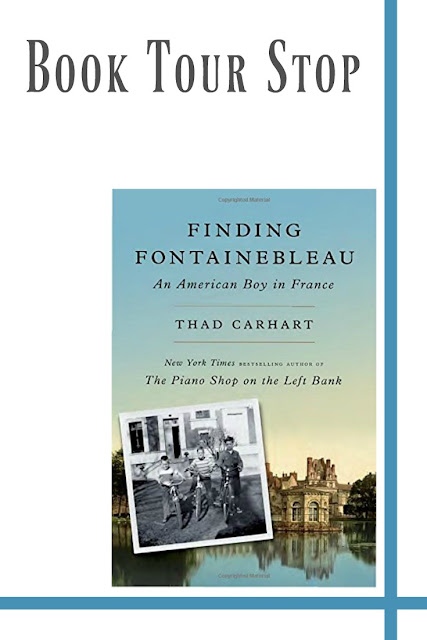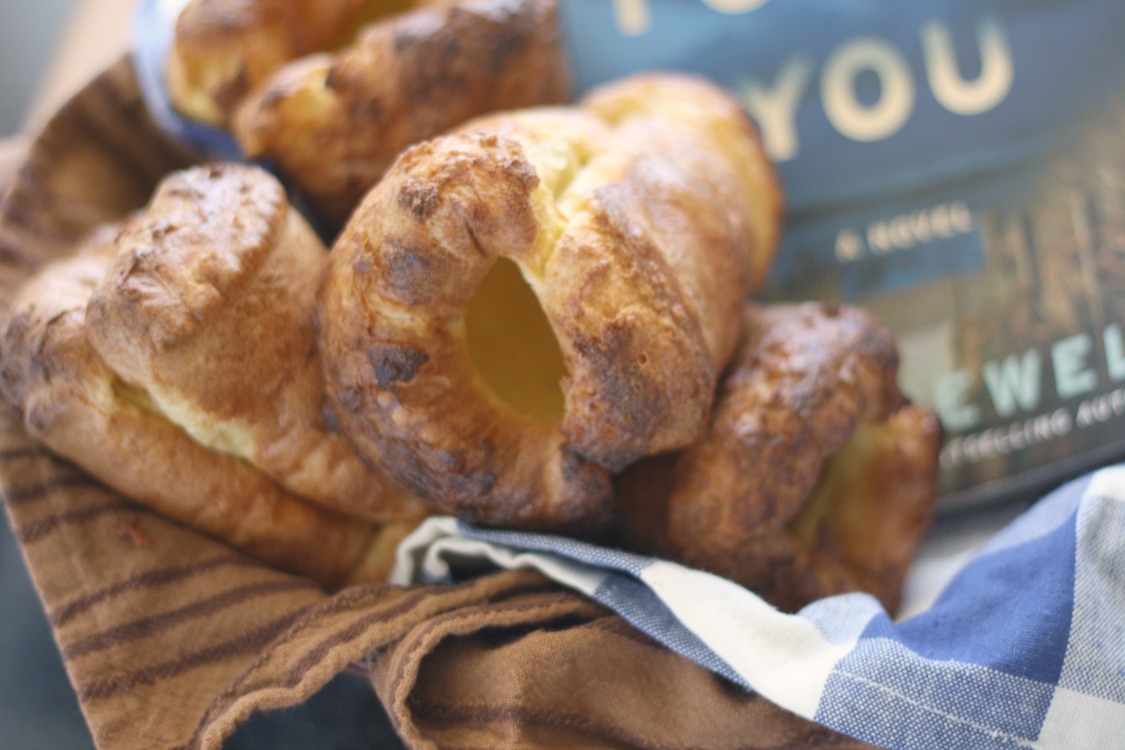I have a weird relationship with memoirs. I'm usually hesitant to say that I enjoy them as a genre, since they vary so much. In general, I like them...history, culture, and memories told from first-hand experience. When they're good, they're really good. I love the ones that I can get carried away in, as if the author pulled me right into a different time and place.
Then there are the ones that don't hold my attention. The subject matter can vary so much, that I suppose that's understandable. For me, this one lies somewhere in between. While I don't consider myself a Francophile, I do love most things France (especially the food and its history). This memoir had both, but sadly I had a bit of a hard time getting through this one. I think it may have been the "place I'm in right now". I'm busy and have too much in my head, which made it hard for me to stay tuned when the author went into drawn-out explanations about the history of the château.
We walked through the market on one of those first mornings and the memory is still intense: boundless, frenetic activity on all sides, with the screams arising from vendors and clients alike; piles of fruits and vegetables set up perfectly on the carts; big chalkboards announcing the prices, with selections weighed out on old-style balance scales with graduated counterweights; dead chickens and rabbits and ducks hanging upside down at the butcher's carts, their feathers and fur streaked with blood; smells that bombarded me, suddenly replaced by other, stronger smells in one long assault on the senses; flowers and herbs and cheeses, and people laughing and arguing and constantly moving. We emerged as from a downpour, blinking slightly. I still remember my surprise and disappointment when I discovered that, by the afternoon, the whole thing simply disappeared—gone, like a circus that had left town. But it returned in the mornings three times a week. p.49
I think that I need to revisit this one after the kids go back to school and I can carve out a few solid "quiet" hours in my day, as I think it will help me focus, which hopefully will in turn hold my attention.
That being said, it is well written with memories that are vibrant and detailed (especially considering that the author was so young when his family relocated). It would fit well on the bookshelf of any Francophile, history buff, or those interested in architecture.
Finding Fontainebleau
author: Thad Carhart
publisher: Viking (May 17, 2016)
genre: memoir
hard cover : 304 pages
"foodie" read: No, but...France!
random excerpt: Later that same week she entered the second, darker kitchen in the late morning to find a woman she had never before seen doing something she had never before imagined: sitting at the small table, prim and proper, eating a peeled banana with a knife and fork. p.49
teaser: Finding Fontainebleau recounts the adventures of Carhart and his family—his NATO officer father, his mother, four siblings, and their dog—in the provincial town of Fontainebleau, France, in the 1950s. Dominating life in the town is the beautiful Château of Fontainebleau. Begun in 1137, fifty years before the Louvre and more than five hundred before Versailles, the Château was a home for Marie-Antoinette, François I, and the two Napoleons, among others, all of whom added to its splendors without appreciably destroying the work of their predecessors.
With characteristic warmth and humor, Carhart takes readers along as he and his family experience the pleasures and particularities of French life: learning the codes and rules of a French classroom where wine bottles dispense ink, camping in Italy and Spain, tasting fresh baguettes. Readers see post-war life in France as never before, from the parks and museums of Paris (much less crowded in the 1950s, when you could walk through completely empty galleries in the Louvre) to the quieter joys of a town like Fontainebleau, where everyday citizens have lived on the edges of history since the 12th century and continue to care for their lieux de mémoire—places of memory.
Intertwined with stories of France’s post-war recovery are profiles of the monarchs who resided at Fontainebleau throughout the centuries and left their architectural stamp on the palace and its sizeable grounds. Carhart finds himself drawn back as an adult, eager to rediscover the town of his childhood. FINDING FONTAINEBLEAU imagines a bright future for this important site of French cultural heritage, as Carhart introduces us to the remarkable group of architects, restorers, and curators who care for and refashion the Château’s hundreds of rooms for a new generation of visitors. Guided by Patrick Ponsot, head of the Château’s restoration programs, the author takes us behind the scenes and shows us a side of the Château that tourists never see.
about the author: Twenty-six years ago Thad Carhart moved to Paris with his wife and two infant children. He lives there now, with frequent visits to New York and Northern California. His first book, The Piano Shop on the Left Bank, appeared in 2000, published by Random House. Across the Endless River, a historical novel, came out in 2009 with Doubleday.
connect with the author: website | facebook | twitter
food pairing: French pastries such as Kouign Amann or croissants...or anything French, really.
author: Thad Carhart
publisher: Viking (May 17, 2016)
genre: memoir
hard cover : 304 pages
"foodie" read: No, but...France!
random excerpt: Later that same week she entered the second, darker kitchen in the late morning to find a woman she had never before seen doing something she had never before imagined: sitting at the small table, prim and proper, eating a peeled banana with a knife and fork. p.49
teaser: Finding Fontainebleau recounts the adventures of Carhart and his family—his NATO officer father, his mother, four siblings, and their dog—in the provincial town of Fontainebleau, France, in the 1950s. Dominating life in the town is the beautiful Château of Fontainebleau. Begun in 1137, fifty years before the Louvre and more than five hundred before Versailles, the Château was a home for Marie-Antoinette, François I, and the two Napoleons, among others, all of whom added to its splendors without appreciably destroying the work of their predecessors.
With characteristic warmth and humor, Carhart takes readers along as he and his family experience the pleasures and particularities of French life: learning the codes and rules of a French classroom where wine bottles dispense ink, camping in Italy and Spain, tasting fresh baguettes. Readers see post-war life in France as never before, from the parks and museums of Paris (much less crowded in the 1950s, when you could walk through completely empty galleries in the Louvre) to the quieter joys of a town like Fontainebleau, where everyday citizens have lived on the edges of history since the 12th century and continue to care for their lieux de mémoire—places of memory.
Intertwined with stories of France’s post-war recovery are profiles of the monarchs who resided at Fontainebleau throughout the centuries and left their architectural stamp on the palace and its sizeable grounds. Carhart finds himself drawn back as an adult, eager to rediscover the town of his childhood. FINDING FONTAINEBLEAU imagines a bright future for this important site of French cultural heritage, as Carhart introduces us to the remarkable group of architects, restorers, and curators who care for and refashion the Château’s hundreds of rooms for a new generation of visitors. Guided by Patrick Ponsot, head of the Château’s restoration programs, the author takes us behind the scenes and shows us a side of the Château that tourists never see.
about the author: Twenty-six years ago Thad Carhart moved to Paris with his wife and two infant children. He lives there now, with frequent visits to New York and Northern California. His first book, The Piano Shop on the Left Bank, appeared in 2000, published by Random House. Across the Endless River, a historical novel, came out in 2009 with Doubleday.
connect with the author: website | facebook | twitter
food pairing: French pastries such as Kouign Amann or croissants...or anything French, really.
I received a complimentary copy of this book in exchange for my honest review.







